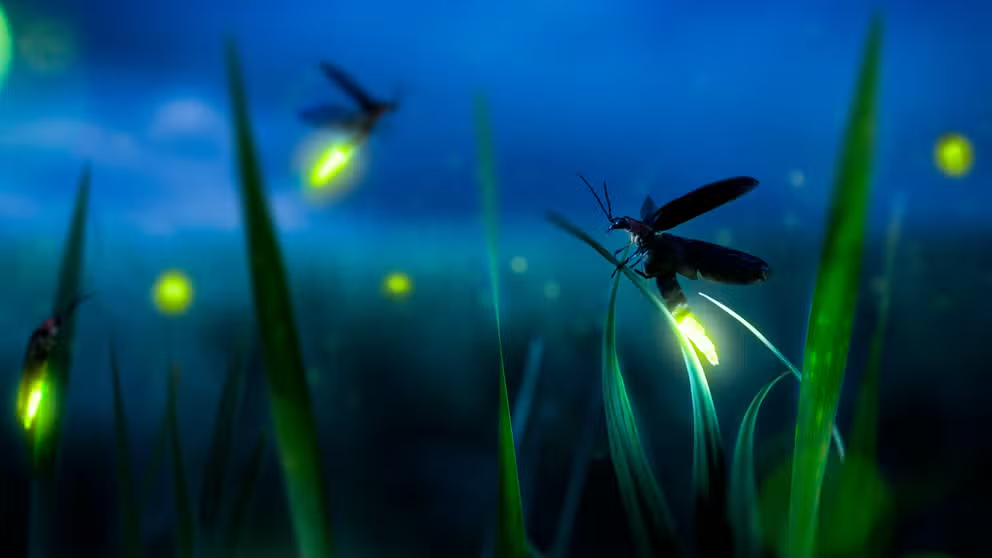Great Smoky Mountains National Park set for mesmerizing display of synchronous fireflies
The insects, such as synchronous fireflies, flash their lights to find their mates.
Why thousands of fireflies put on a magical light show each year
For the synchronous firefly, what appears as a dazzling spring and summertime spectacle is largely a courtship ritual.
GATLINBURG, Tenn. – They’re as close to the stars as we’ll ever get — blinking dots of gold that pepper the pitch-dark night, all caused by the flash of fireflies.
What appears as a lovely spring and summertime spectacle across parts of the U.S. is largely a courtship ritual for the insects, and their glow is a sign that they’re looking for romance.

Great Smoky Mountains National Park.
(Thom McManus / Great Smoky Mountains National Park)
"I'm always happy to see the first fireflies of the season," said Becky Nichols, an entomologist in Great Smoky Mountains National Park. "To me, it signifies that it's a healthy ecosystem, and that we're doing our job to protect their habitat."
Perhaps one of the best places to witness this glowing courtship that lights up forests is on the eastern edge of Tennessee.
Great Smoky Mountains National Park holds a firefly viewing event, typically around the end of May through the first part of June, for eight days and eight nights in their Elkmont Campground.
The area has one of the largest populations of synchronous fireflies in the park. In fact, the firefly viewing has become such a popular event over the years that the park started hosting a lottery for the viewing event.
"We started managing this area because so many people would come here, and it was beginning to have an impact on not only the visitors' experience, but also on the resources themselves," Nichols said.
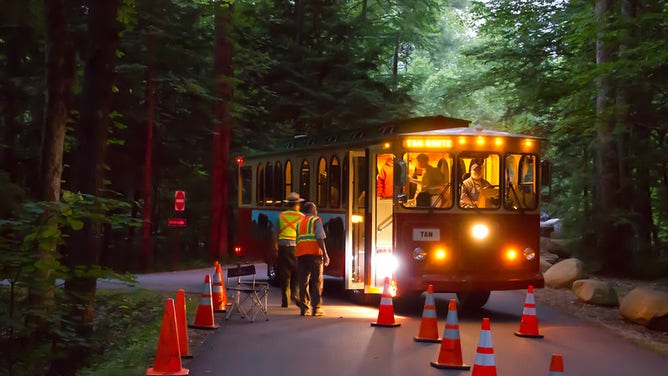
Trolley of visitors coming to see the synchronous firefly viewing event.
(Warren Bielenberg / Great Smoky Mountains National Park)
Having a lottery also ensures the safety and overall experience for visitors, who come to watch the fireflies in the woods in total darkness.
Visitors who win the lottery are able to purchase a ticket to visit the park on a selected night. They walk up a trail to watch the firefly light show at around 9:30 p.m., and the show lasts for about two hours.
GLOWING REVIEW: EXPLORING THE BEAUTY OF BIOLUMINESCENCE
"You don't have to hike far — you just walk up the trail, find a good, nice open area in the woods — and the Rangers are there to help find a good place," Nichols said. "It's a great experience."
What causes fireflies to light up:
According to Nichols, fireflies spend the majority of their lives in a larval stage on the forest floor. When they mature and reach the adult stage – typically in the early spring and throughout the summer — the insects emerge as full-grown fireflies capable of showcasing their signature glow.
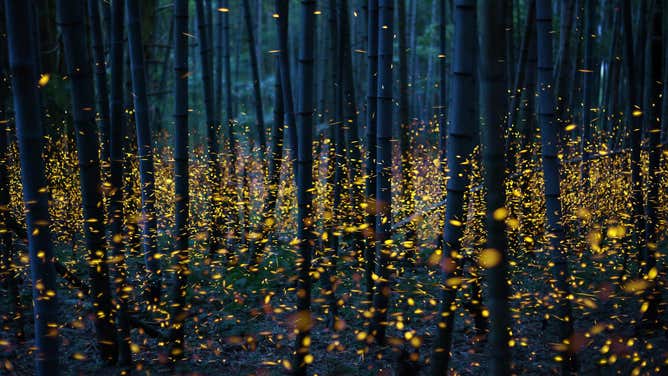
Fireflies light up a forest.
(Kei Nomiyama / Future Publishing / Getty Images)
Some firefly species may even glow in shifts.
"It's interesting that the evening hours are actually divided up by different species," Nichols said. "Some will go from 8 to 8:30 p.m. Others will go from 8:30 p.m. to 9 p.m. They have these different niches in time during the evening hours when they do their flashing behavior."
This glow is known as bioluminescence, the production of light by a living organism.
"Fireflies produce light by mixing two chemicals that they store in their body," Nichols said. "One is called luciferin and the other is an enzyme called luciferase. When they mix these two chemicals in the presence of oxygen, light is produced."
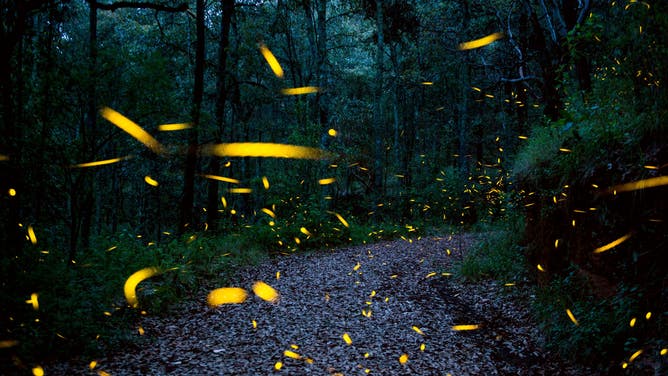
Fireflies illuminate a path through a forest.
(Mario Vazquez de la Torree / AFP / Getty Images)
As mesmerizing as bioluminescence can be in fireflies, it’s not without its purpose.
"Primarily, the function of the flashing is for mate recognition," Nichols said. "In order for the males to find the females in total darkness, usually they have to have a method for communicating."
Males will communicate by using a particular flash pattern. Then, the females will flash in response.
According to Nichols, females are often on the forest floor, so their flashing is not as pronounced. This means that the flashing most people see at night is coming from male fireflies.
What makes fireflies in the Smokies stand out?
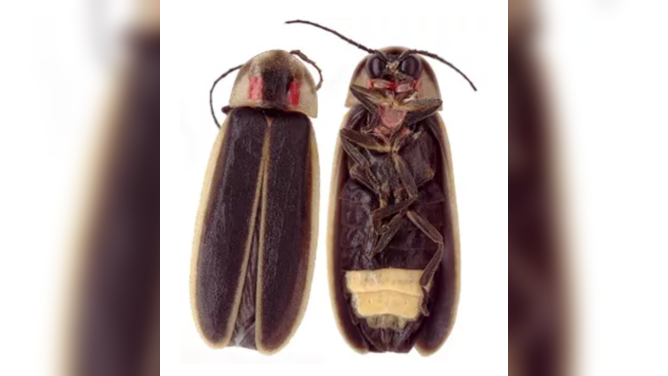
Synchronous fireflies produce light in their lanterns, the pale area of the abdomen visible on the underside of the insect above.
(Great Smoky Mountains National Park)
In one species of firefly, called the synchronous firefly, the insects flash in sync with one another.
"In many cases, when they first start early in the evening, there will be a little bit disorganized and not quite synchronized," Nichols said. "But as more and more males start joining the flashing as the night goes on and you're right in the middle of the season, then the whole forest can be just pulsating with lights. It's really an amazing thing to see."
According to Nichols, this synchronized flashing is believed to be another way for females to recognize males. The female synchronous firefly requires a tremendous amount of light input for her to respond back to and to recognize that she’s flashing back to the right firefly species.
GIANT INVASIVE SPIDERS SPOTTED IN GREAT SMOKY MOUNTAINS NATIONAL PARK
"Otherwise, she could be signaling to the wrong species, and there are predatory species out there as well that could zero in on her if she flashes to the wrong species," Nichols said.
A great activity for families

Families at Great Smoky Mountains National Park firefly viewing event.
(Warren Bielenberg / Great Smoky Mountains National Park)
For Nichols, the popularity of the firefly viewing may have to do with tradition, particularly with families.
"I think it's become so popular because a lot of people probably remember seeing fireflies when they were kids, and they want their children to experience the same thing," she said.
Some visitors may even live in places where fireflies may not flourish, so the firefly event is even more of a spectacle.
"The kids just totally enjoy being out in the woods in total darkness and seeing the fireflies," Nichols said.
This year, the firefly viewing event will take place at Elkmont from May 29-June 5.
For a chance to partake and see the fireflies, you can enter the lottery by Monday, May 5 at 11:59 p.m. ET through recreation.gov.
